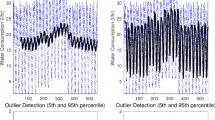Abstract
The water distribution system constantly aims at improving and efficiently distributing water to the city. Thus, understanding the nature of irregularities that may interrupt or exacerbate the service is at the core of their business model. The detection of technical and non-technical losses allows water companies to improve the sustainability and affordability of the service. Anomaly detection in water consumption is at present a challenging task. Manual inspection of data is tedious and requires a large workforce. Fortunately, the sector may benefit from automatized and intelligent workflows to reduce the amount of time required to identify abnormal water consumption. The aim of this research work is to develop a methodology to detect anomalies and irregular patterns of water consumption. We propose the use of algorithms of different nature that approach the problem of anomaly detection from different perspectives that go from searching deviations from typical behavior to identification of anomalous pattern changes in prolonged periods of time. The experiments reveal that different approaches to the problem of anomaly detection provide complementary clues to contextualize household water consumption. In addition, all the information extracted from each approach can be used in conjunction to provide insights for decision-making.
Access this chapter
Tax calculation will be finalised at checkout
Purchases are for personal use only
Similar content being viewed by others
References
Lambert, A., Hirner, W.: Losses from water supply systems: standard terminology and recommended performance measures, Report P-13, International Water Association (2000)
Chandola, V., Banerjee, A., Kumar, V.: Anomaly detection: a survey. ACM Comput. Surv. 41, 1–58 (2009)
Vercruyssen, V., Meert, W., Verbruggen, G., Maes, K., Baumer, R., Davis, J.: Semi-supervised anomaly detection with an application to water analytics. In: IEEE International Conference on Data Mining (ICDM), pp. 527–536, November 2018
Sun, J., Lou, Y., Ye, F.: Research on anomaly pattern detection in hydrological time series. In: 14th Web Information Systems and Applications Conference (WISA), pp. 38–43, November 2017
Dogo, E.M., Nwulu, N.I., Twala, B., Aigbavboa, C.: A survey of machine learning methods applied to anomaly detection on drinking-water quality data. Urban Water J. 16(3), 235–248 (2019)
Muharemi, F., Logofătu, D., Leon, F.: Machine learning approaches for anomaly detection of water quality on a real-world data set. J. Inf. Telecommun. 3(3), 294–307 (2019)
Quinn, S., Murphy, N., Smeaton, A.F.: Tracking human behavioural consistency by analysing periodicity of household water consumption. In: Proceedings of the 2019 2nd International Conference on Sensors, Signal and Image Processing, SSIP 2019, New York, NY, USA, pp. 1–5. Association for Computing Machinery (2019)
González-Vidal, A., Cuenca-Jara, J., Skarmeta, A.F.: IoT for water management: towards intelligent anomaly detection. In: IEEE 5th World Forum on Internet of Things (WF-IoT), pp. 858–863, April 2019
Christodoulou, S.E., Kourti, E., Agathokleous, A.: Waterloss detection in water distribution networks using wavelet change-point detection. Water Resources Manage. 31, 979–994 (2017)
Romano, M., Kapelan, Z., Savić, D.A.: Automated detection of pipe bursts and other events in water distribution systems. J. Water Resour. Plann. Manage. 140(4), 457–467 (2014)
Kermany, E., Mazzawi, H., Baras, D., Naveh, Y., Michaelis, H.: Analysis of advanced meter infrastructure data of water consumption in apartment buildings. In: Proceedings of the 19th ACM SIGKDD International Conference on Knowledge Discovery and Data Mining, KDD 2013, New York, NY, USA, pp. 1159–1167. Association for Computing Machinery (2013)
Júnior, L.A.P., Ramos, C.C.O., Rodrigues, D., Pereira, D.R., de Souza, A.N., da Costa, K.A.P., Papa, J.P.: Unsupervised non-technical losses identification through optimum-path forest. Electr. Power Syst. Res. 140, 413–423 (2016)
Detroz, J.P., da Silva, A.T.: Fraud detection in water meters using pattern recognition techniques. In: Proceedings of the Symposium on Applied Computing, SAC 2017, New York, NY, USA, pp. 77–82. Association for Computing Machinery (2017)
Cleveland, R.B., Cleveland, W.S., McRae, J.E., Terpenning, I.: STL: a seasonal-trend decomposition procedure based on loess. J. Off. Stat. 6, 3–37 (1990)
Vallis, O., Hochenbaum, J., Kejariwal, A.: A novel technique for long-term anomaly detection in the cloud. In: Proceedings of the 6th USENIX Conference on Hot Topics in Cloud Computing, HotCloud 2014, USA, p. 15. USENIX Association (2014)
Truong, C., Oudre, L., Vayatis, N.: Selective review of offline change point detection methods. Sig. Process. 167, 107299 (2020)
Wambui, G.D., Waititu, G.A., Wanjoya, A.K.: The power of the pruned exact linear time(pelt) test in multiple changepoint detection. Am. J. Theor. Appl. Stat. 4(6), 581–586 (2015)
Acknowledgment
This research work is cofounded by the European Regional Development Fund (FEDER) under the FEDER Catalonia Operative Programme 2014–2020 as part of the R+D Project from RIS3CAT Utilities 4.0 Community with reference code COMRDI16-1-0057.
Author information
Authors and Affiliations
Corresponding authors
Editor information
Editors and Affiliations
Rights and permissions
Copyright information
© 2021 Springer Nature Switzerland AG
About this paper
Cite this paper
Carrasco-Jiménez, J.C., Baldaro, F., Cucchietti, F. (2021). Detection of Anomalous Patterns in Water Consumption: An Overview of Approaches. In: Arai, K., Kapoor, S., Bhatia, R. (eds) Intelligent Systems and Applications. IntelliSys 2020. Advances in Intelligent Systems and Computing, vol 1250. Springer, Cham. https://doi.org/10.1007/978-3-030-55180-3_2
Download citation
DOI: https://doi.org/10.1007/978-3-030-55180-3_2
Published:
Publisher Name: Springer, Cham
Print ISBN: 978-3-030-55179-7
Online ISBN: 978-3-030-55180-3
eBook Packages: Intelligent Technologies and RoboticsIntelligent Technologies and Robotics (R0)




